UK’s house price growth highest in almost 18 years
UK house prices continue to rise strongly, amidst robust demand and a chronic housing shortage. The average house price in the UK increased by 12.6% to £260,771 (US$ 320,258) during the year to Q1 2022, according to Nationwide – a sharp acceleration from the previous year’s 6.3% growth. In fact, it was the country’s largest house price rise since 2004. When adjusted for inflation, house prices rose by 6.3% in Q1 2022 from a year earlier.
All other regions saw house price rises during the year to Q1 2022, with London registering the lowest growth of 7.4% to an average of £518,333 (US$ 636,615) – up from the prior year’s 4.8% increase. London’s prices are now about 70% above the 2007 peak levels.
Wales saw the biggest growth, with house prices rising by 15.3% during the year to Q1 2022 (9.3% inflation-adjusted). It was followed by South West and East Anglia, with price increases of 14.4% and 14.2%, respectively. Strong house prices were also seen in Yorkshire and Humberside (13.5%), East Midlands (13.5%), Outer South East (12.8%), North West (12.4%), Scotland (12%), West Midlands (11.7%), Outer Metropolitan Area (11.4%), Northern Ireland (11.1%), and the North (10.6%).
During 2021, residential property transactions in the UK soared by about 41.2%, to around 1,475,740, following an 11.2% decline in the previous year, according to HM Revenue & Customs. In the first four months of 2022, there were 385,060 residential property transactions in the UK, down 24% from a year earlier but still up 12% from the same period in 2019 before the pandemic. This was amidst the expiration of the temporary stamp duty holiday introduced during the peak of the Covid-19 lockdown.
Aside from robust demand, the acute housing shortage in the country is pushing prices up. About 8.4 million people in England are living in unaffordable, insecure, or unsuitable homes, according to the National Housing Federation. And despite the increase in residential construction activity last year, completions remain far below the government’s target of 300,000 new homes every year.
The UK housing market is expected to continue growing, albeit at a slower pace, primarily due to rapidly rising borrowing costs, coupled with the inflationary pressures currently exerted on household budgets and the adverse impact of the Ukraine war. Savills predicts an annual house price growth of 7.5% this year.
United Kingdom’s house price annual change
Property listings website Rightmove expects a more muted house price increase this year, of about 5%. It expects the most competitive markets of Scotland, West Midlands, South West, and Yorkshire and the Humber to see price growth above 7% in 2022, while London’s price increase will be more subdued at 3%. Zoopla expects property values across the UK to rise by 3.5% by year-end, mainly due to economic headwinds, including increases in mortgage rates and rising cost of living.
“After a very strong first half of the year, it is likely that the housing affordability crunch will have a greater impact on market behaviour in the months ahead, with further interest rate rises anticipated during that period," said Tim Bannister of Rightmove.
The UK economy grew strongly by 8.7% year-on-year in Q1 2022, up from its 6.6% expansion in the previous quarter, buoyed by strong construction and services sectors. Yet on a quarterly basis, the economy advanced by only 0.8% in Q1 2022. Modest economic growth is projected this year at 3.7%, following strong growth of 7.4% in 2021 and a historic plunge of 9.3% in 2020, according to the International Monetary Fund (IMF).
In June 2022, the Bank of England (BoE) raised its key rate by another 25 basis points to 1.25%, its fifth consecutive rate hike since December 2021, in an effort to meet its inflation target of 2%. It is the highest level in more than 13 years.
The housing boom and bust in the UK
UK property prices saw huge rises from 1996 to 2007:
- Prices in London rose 289.1% (228.1% in real terms).
- Prices in Northern Ireland rose by 393.2% from Q3 1996 to Q3 2007 (315.9% in real terms), the highest rise among UK regions.
- Price increases in other regions ranged from 187.9% (142.8% in real terms) for Scotland, to 245.5% (191.3% real) for the Outer Metropolitan Area.
- The national index rose 240.9% (187.5% in real terms) over the same period (all figures from Nationwide).
In early 2007 interest rates were raised, and lending conditions tightened. House price falls accelerated in H2-2008, due to the global financial meltdown. The biggest falls occurred in Northern Ireland where house prices fell by 39.2% (-41.9% real). London house prices fell by 19.8% (-23.3% in real terms).

The housing market started to recover in 2013, with nationwide house prices rising by 45.1% (32% real) from 2013 to 2021. London had one of the biggest price growths, up 46.9% (32.6% real) over the past eight years.
The UK’s and particularly London’s house price rises have, over the past decade, been fuelled by four factors:
- Strong immigration and population growth, especially in London.
- Interest rates are at record lows, with a large expansion of the money supply through “quantitative easing”.
- Strong growth of the City of London.
- Construction activity remains weak (though this is less true of London).
The UK housing market is expected to remain robust this year, but the rate of growth will slow as borrowing costs rise rapidly.
The price gap between London and the rest of the UK narrowing
The gap between London and the rest of the UK is now declining, amidst continued house price falls in the capital city. In Q1 2022, the average London home is worth more than double the average home elsewhere in the UK – a huge gap, but the lowest since Q3 2013. The average difference in price is £276,178 (US$ 337,720).
The gap between London prices and the rest of the UK peaked in Q1 2017, when home prices in the capital were 154% higher than the rest of the country, with an average price difference of £290,140 (US$ 354,857).
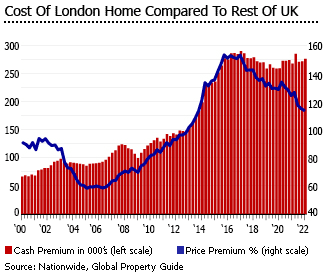
Despite the falling gap since Q2 2017, the average house price in London remains about 71.4% higher than at its peak in 2007. All other regions, except Northern Ireland, have higher property values in Q1 2022 than their 2007 peak prices:
- Outer Metropolitan London is 63.3% up on the 2007 peak.
- Outer South East is 56.5% up on 2007.
- East Anglia is up by 50.9%.
- South West is up by 47.2%.
- East Midlands is up by 44.8%.
- West Midlands is up by 41.2%.
- North West is up by 28.6%.
- Yorkshire and Humberside is up by 27.4%
- Wales is up by 31.1%.
- Scotland is up by 16.9%.
- North is up by 13.7%
Northern Ireland had the weakest performance, with prices still 24.9% lower than at the 2007 peak.
Demand rising strongly
During 2021, residential property transactions in the UK soared by about 41.2%, to around 1,475,740, following an 11.2% decline in the prior year, according to HM Revenue & Customs.
Over the same period:
- In England, residential property transactions surged by 42.2% to 1,263,000, in contrast to a 10.3% fall in 2020
- In Scotland, transactions were up 28.4% to 114,200, following a 14.8% fall in the prior year
- In Wales, transactions rose sharply by 42.6% to 64,160, following an 18.6% decline in 2020
- In Northern Ireland, transactions rose strongly by 49.2% y-o-y to 34,180, in contrast to a 16.5% decline in 2020
“The coronavirus pandemic caused substantial decreases for UK residential transactions during 2020 quarter 2, followed by increasing transactions as the UK housing market re-opened and significant peaks in March, June and September 2021 caused by the ending or changing of temporarily increased nil rate bands for residential property taxes within different UK nations,” said HM Revenue & Customs.
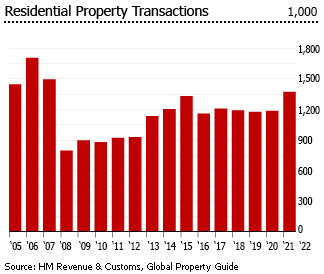
In the first four months of 2022, there were 385,060 residential property transactions in the UK, down 24% from a year earlier. The decline from last year was not surprising given the expiration of the temporary stamp duty holiday introduced during the peak of the Covid-19 lockdown.
Residential construction rising again but the chronic housing shortage persists
UK’s residential construction activity is rising strongly again after it was negatively affected by the government’s Covid-19 lockdown measures in 2020.
- Dwelling starts soared 34.8% to 174,880 units during 2021, following a 15.2% fall in 2020, according to the Ministry of Housing, Communities & Local Government.
- Completions rose strongly by 18.6% y-o-y to 175,390 dwelling units over the same period, in contrast to a 16.9% decline in the prior year.
Despite the recovery, it remains far below the government’s target of 300,000 new homes every year. Moreover, the UK’s per capita housebuilding rate remains low by international standards and failed to respond sufficiently to rising house prices during the boom, due to planning constraints.
For instance, in 2019, there were about 178,800 home completions in the UK. However at least 250,000 new homes must be built annually to match population growth, to replace the ageing housing stock and the accumulated backlog, says the Town and Country Planning Association (TCPA).

Homebuilding in the UK stagnated at an average of 186,000 new units annually between 1991 and 2003, and from 2004 onwards barely exceeded 200,000 annually (222,940 in 2007).
“Every government arrives in office pledging to boost the number of new homes being built but the facts speak for themselves: in the 30 years from 1958 to 1988 around 7.5m homes were built in England. In the subsequent three decades the number more than halved to around 3.1m,” said Larry Elliot of The Guardian. “The supply of homes is affected by tough green belt regulations, local planning rules and by the lack of a land value tax to deter hoarding.”
According to Rightmove, the chronic housing shortage in the UK is the primary driver of record house price rises in recent years.
Raising housing supply and other reforms
The Covid-19 pandemic brought about some immediate changes to the country’s planning policy, including enabling pubs to offer hot food takeaway services and changes related to permitted development rights (PDRs). But even before the pandemic, a reform of the planning system was already the subject of consultation to speed the system up and expand the housing supply. A housing white paper published in August 2020, including a concurrent consultation, details the government’s plans for upcoming changes to the planning system, including automatic approval for designated areas, priority for high-quality developments, replacing Section 106 by infrastructure levy, and discounts for developers building affordable homes.
“The whole thing is beginning to crumble and the time has come to do what too many have for too long lacked the courage to do – tear it down and start again,” said Prime Minister Boris Johnson. “That is what this paper proposes. Radical reform, unlike anything we have seen since the second world war.”
“Not more fiddling around the edges, not simply painting over the damp patches, but levelling the foundations and building, from the ground up, a whole new planning system for England,” PM Johnson added.
The government published its response on local housing needs on December 2020, alongside a written ministerial statement. In February 2021, the Levelling Up white paper was released outlining various proposals related to planning. Then in March 2021, the consultation outcome on revised PDRs, housing delivery and public infrastructure was published. In a statement to the House of Commons in February 2022, the Secretary of State for Levelling Up Michael Gove outlined its planning and regeneration measures.
With the Covid-19 situation already subsiding, it is hoped that the proposed drastic changes to the planning system will come to fruition.

Before the proposed reform to the planning system, the government had already undertaken several measures in the past to address supply shortages. By end-2020, £7.1 billion was allocated over 4 years to a National Home Building Fund to build more affordable, and sustainable homes across England. In addition, the Tenant Fees Act 2019 has banned letting agents’ fees to tenants.
In 2014 a Starter Homes policy was announced to address the affordable housing crisis. The Starter Homes policy is aimed at households with combined incomes below £80,000 (US$98,187), or £90,000 (US$110,460) in London. Starter homes must cost a minimum of 20% less than the market value, and the maximum price after the discount will be £450,000 (US$ 552,302) in London and £250,000 (US$ 306,872) elsewhere. Buyers of starter homes will need a mortgage. If the property is resold within 15 years, some or all of the discount must be repaid.
But a review conducted by the National Audit Office in November 2019 showed that building had not yet commenced, despite £173 million being spent to buy land for affordable properties, partly because enabling legislation was never passed. As such, the policy was formally scrapped in 2020 and was replaced by a new scheme aimed to deliver only 6,600 homes – and only about 36% of these homes will meet the current definition of affordable housing, according to Homes England. This left about 85,000 young people waiting in vain for an affordable home to live.
Interest rates rising rapidly
In June 2022, the Bank of England (BoE) raised its key rate by another 25 basis points to 1.25%, its fifth consecutive rate hike since December 2021, in an effort to meet its inflation target of 2%. It is the highest level in more than 13 years. Inflation in the UK soared to 9.1% in 12 months to May 2022, up from just 2.1% in the previous year and the highest level in four decades, as food and energy prices continue to surge.
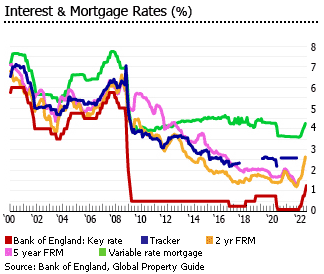
“The Bank of England’s Monetary Policy Committee (MPC) sets monetary policy to meet the 2% inflation target, and in a way that helps to sustain growth and employment,” said the central bank. “At its meeting ending on 15 June 2022, the MPC voted by a majority of 6-3 to increase Bank Rate by 0.25 percentage points, to 1.25%.”
As expected, mortgage rates are now rising. In May 2022, average interest rates for types of mortgages with 75% loan to value (LTV) were:
- 2-year fixed-rate mortgages (FRMs): 2.63%, up from 1.47% a year earlier and 1.42% two years ago
- 3-year FRMs: 2.57%, up from 1.71% in May 2021 and 1.64% in May 2020
- 5-year FRMs: 2.63%, up from 1.68% a year earlier and 1.7% two years ago
- 10-year FRMs: 2.86%, slightly up from 2.59% a year earlier and 2.4% in May 2020
- Standard variable rate mortgages: 4.25%, up from 3.61% a year ago and from 3.65% two years prior
The mortgage market expanding again
After an abrupt pause in 2020 due to the pandemic, the UK’s mortgage market is recovering rapidly, as buyers and investors return to the market amidst improved economic conditions. During 2021, the total number of approvals for lending secured on dwellings rose by 11.9% to 1,570,312 compared to a year earlier, after falling by 9.4% in 2020.
During 2021:
- House purchase loan approvals rose strongly by 15.6% to 944,014, an acceleration from a modest growth of 3.6% in 2020, according to the Bank of England. It was the largest number of approvals since 2007.
- Remortgage approvals increased slightly by 1.9% to 459,853 during 2021, in stark contrast to a y-o-y decline of 23.1% in 2020.
- Other secured lending approvals rose by 23.8% y-o-y to 166,445, following a 22.2% fall in the prior year.
As such, the total value of outstanding residential mortgage loans increased 4.4% to £1.63 trillion (US$1.99 trillion) in Q1 2022 from a year earlier, according to the Bank of England.
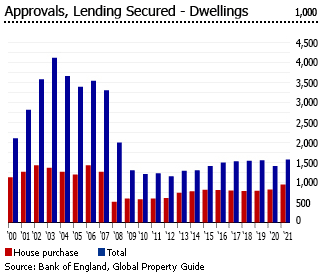
The top five lenders accounted for more than 63% of outstanding mortgage loans last year (Lloyds Banking Group, 17.2%; Nationwide BS, 12.6%; NatWest Group, 12.5%; Santander UK, 11.5%; and Barclays, 9.3%), according to UK Finance.
Arrears and repossessions remain low
Despite the financial strain to borrowers caused by the pandemic, arrears and repossessions in 2021 remained near at their record low levels, thanks to the various help and forbearance offered by lenders to struggling borrowers.
In Q1 2022, there were 75,670 homeowner mortgages in arrears of 2.5% or more of the outstanding balance, down by 9.9% from a year earlier and by 1.8% two years ago, according to UK Finance. Likewise, buy-to-let mortgage arrears fell by 5.2% y-o-y in Q1 2022 to 5,860.
“The number of customers in arrears remains low and fell for the fourth quarter in a row. The number of homeowner mortgages in arrears is now 10 per cent lower than a year ago and buy-to-let mortgage arrears are 5 per cent lower for the same period,” said UK Finance.
Over the same period:
- Arrears of 2.5% to 5% of balance: down 19.2% y-o-y to 24,980
- Arrears of 5% to 7.5% of balance: down 12.3% y-o-y to 13,200
- Arrears of 7.5% to 10% of balance: down 12.7% y-o-y to 8,150
- Arrears over 10% of balance: up slightly by 2.2% y-o-y to 29,340
In Q1 2022, there were 580 homeowner mortgage possessions, up from 200 a year earlier, as the voluntary possessions moratorium in response of the Omicron variant, ended on January 4, 2022. Likewise, buy-to-let mortgage possessions increased to 370 in Q1 2022 from 180 a year ago.

“It is important to note that year-on-year comparisons [of repossessions] will look unusually large due to the Possession Moratorium from March 2020 - 1 April 2021, over which period no enforced possessions took place,” said UK Finance. “In absolute terms, there were 240 more possessions in Q1 2022 compared with the previous quarter, however, the total for this quarter is less than half the total in Q4 2019.”
“The voluntary possessions moratorium, in response to the Omicron variant, ended on 4 January 2022, and the number of possessions has been gradually increasing as the courts resume working through the backlog of cases accumulated over the first moratorium,” UK Finance added.
Help-to-Buy scheme extended into 2022; new version introduced
On December 21, 2021, the Finance Act 2021 became law, extending the Help-to-Buy scheme in its current enhanced form for a further year to the end of 2022. The Help-to-Buy scheme helps first-time homebuyers to purchase or self-build a new house or apartment. The scheme will be reviewed in the course of 2022.
Through the Help-to-Buy Equity Loan, the government loans homebuyers up to 20% (or 40% in London) of the full purchase price of a new-build property, provided that borrowers contribute 5% of the property price as a deposit, and secure a mortgage for the remaining 75% of a property. The homebuyer is not allowed to sub-let the property and it must also be his/her only property.
Since its inception in 2013 until May 2022, over 350,000 homes have been bought using it.
Recently, the government announced a new scheme with tighter lending criteria to run from April 2021 until March 2023. Unlike the current scheme, the new version will be restricted to first-time buyers, which means that a buyer cannot have owned a home in the UK or abroad before. Moreover, the new scheme will include regional property price caps to ensure that it helps those people who need it most. The cap is 1.5 times the average first-time buyer price in the area.
Property price cap per region under the new scheme:
- In London, the maximum property price which qualifies for a loan is £600,000 (US$ 736,737)
- In Yorkshire, the price limit is £228,100 (US$ 280,081)
- In the North-East, the price limit is £186,100 (US$ 228,510)
- In the North-West, the cap is £224,400 (US$ 275,500)
- In East Midlands, the price limit is £261,900 (US$ 321,540)
- In West Midlands, the price limit is £255,600 (US$ 313,837)
- In the South-West, the price limit is £349,000 (US$ 428,518)
- In the South-East, the price limit is £437,600 (US$ 537,286)
The loan is interest-free for the first five years. In the sixth year, buyers will be charged an interest of 1.75%. The interest rate will then increase annually based on the consumer price index (CPI) plus 2%. The equity loan must be repaid when the mortgage is repaid, when the home is sold, or after 25 years.
Homes England, the government body that administers the new scheme, estimates that a total of £25 billion (US$ 30.7 billion) will be loaned by 2023.
London rental yields are low
The average rental yields in the UK currently stand at 3.63%, almost unchanged from a year earlier, according to Seven Capital. This is supported by property comparison site Rentround.com, which showed that nationwide rental yields averaged 3.6%.
Yet London has the lowest rental yields in the UK, at just 2.9%, based on Seven Capital’s figures. On the other hand, the North West, Yorkshire & the Humber, Scotland, and Wales have the highest yields, ranging from 4% to 4.4%.
Rental yields in the South East, South West, West Midlands, East Midlands, East, North East and North West range from 3.1% to 3.8%.
The rental market remains tight; rents continue to rise
Rents continue to rise, mainly due to strong demand and a low supply of rental housing. Private rental prices paid by tenants in the UK rose by 2.7% in the twelve months to April 2022, up from the previous month’s 2.4% increase and the largest annual growth since the series began in January 2016, according to the Office for National Statistics.
In April 2022, East Midlands saw the highest annual growth in private rental prices at 4% while London recorded the lowest at 1.1%. Rents rose by 2.9% in Scotland, 2.5% in England, and 1.7% in Wales.
Tenant demand continues to rise at a robust pace, according to the Royal Institution of Chartered Surveyors Residential Market Survey in March 2022.
However, the Association of Residential Letting Agents (ARLA) has recently shown that the average tenancy length has increased to 23 months in March 2022, from 21 months in the previous month, as increasing rental prices and lack of available stock have made it unaffordable for some tenants to move to a new property.
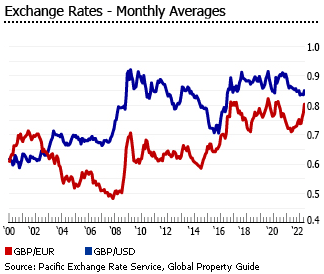
“Our latest report shows that tenants are staying in properties longer. This is in part due to rock bottom levels of stock meaning tenants have very little choice when looking to move. They will also find fierce competition is pushing up prices of what is available often making it unaffordable to move,” said Nathan Emerson, the CEO of Propertymark.
Yet these supply and demand pressures are not fully reflected in the Index of Private Housing Rental Prices (IPHRP), which accounts for price changes of all private rental properties rather than only newly advertised rental properties.
The rental market will continue to grow in the medium term, albeit at a slower pace. “We forecast that the rapid pace of growth in the rental market will slow in 2022. But the rate of increase should still be above pre-pandemic levels. This has been supported by tenants´ willingness to pay for extra space – and by unprecedentedly low stock levels,” said Hamptons International.
“We are forecasting that rents will rise by an average of 2.5% in 2022, following an increase of 3.0% this year,” Hamptons added.
UK economy to grow modestly, inflation is surging
The UK economy grew strongly by 7.4% during 2021, following a historic plunge of 9.3% in 2020 due to the Covid-19 pandemic. Then in Q1 2022, the economy expanded further by 8.7% year-on-year, up from its 6.6% expansion in the previous quarter, buoyed by strong construction and services sectors, according to the Office for National Statistics. Yet on a quarterly basis, the economy advanced by only 0.8% in Q1 2022.
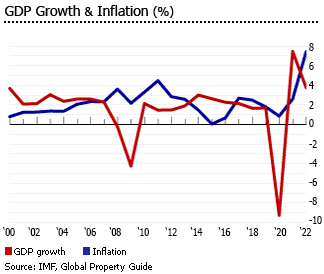
Economic growth is expected to slow in the coming months due to the impact of the Ukraine crisis and as surging inflation hurts the purchasing power of consumers. Recently, the International Monetary Fund (IMF) downgraded its 2022 economic growth forecast for the UK to a modest 3.7%, from its January estimate of 4.7%.
“Consumption is projected to be weaker than expected as inflation erodes real disposable income, while tighter financial conditions are expected to cool investment,” said the IMF.
Before the pandemic, the UK’s economic growth had been anaemic, at best. From 2001 to 2019, the economy expanded by an annual average of just 1.7%.
The UK’s GDP growth per capita figures are also unimpressive. GDP per capita has been growing by an annual average of just 0.3% from 2010 to 2020, and actually plunged by 9.7% in 2020, according to IMF. GDP per capita grew by 6.7% in 2021, as pandemic-related restrictions were loosened due to the low base effects in the prior year.
UK’s overall unemployment rate was 3.8% in the three months to April 2022, down from 4.9% a year earlier, according to the Office for National Statistics. In fact, it was the second lowest level in 48 years. The HM Treasury projects unemployment to be at 3.9% this year.
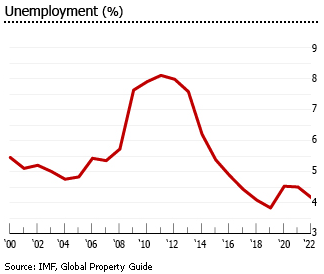
Yet consumer prices are soaring! In May 2022, the UK’s inflation stood at 9.1%, sharply up from 2.1% a year earlier and the highest since the Office for National Statistics began publishing the series in January 1989. Overall inflation averaged 1.6% annually from 2014 to 2021 but is projected to soar to 9.2% this year, according to HM Treasury.
The UK voted to leave the European Union (EU) in 2016 and officially left the trading bloc, its biggest trading partner, on January 31, 2020. Though, both parties agreed to continue their trading arrangements until December 31, 2020, to allow enough time to agree to the terms of a new trade deal.
Sources:
- House price index (Nationwide): https://www.nationwide.co.uk/house-price-index/#tab:Downloaddata
- Monetary Policy Summary, June 2022 (Bank of England): https://www.bankofengland.co.uk/monetary-policy-summary-and-minutes/2022/june-2022
- Consumer price inflation, UK: April 2022 (Office for National Statistics): https://www.ons.gov.uk/economy/inflationandpriceindices/bulletins/consumerpriceinflation/april2022
- Household credit (Bank of England): https://www.bankofengland.co.uk/statistics/visual-summaries/household-credit
- Mortgage Lenders and Administrators Statistics - 2022 Q1 (Bank of England): https://www.bankofengland.co.uk/statistics/mortgage-lenders-and-administrators/2022/2022-q1
- Arrears and Possessions (UK Finance): https://www.ukfinance.org.uk/data-and-research/data/arrears-and-possessions
- Largest Mortgage Lenders (UK Finance): https://www.ukfinance.org.uk/data-and-research/data/largest-mortgage-lenders
- Construction output in Great Britain: April 2022 (Office of National Statistics): https://www.ons.gov.uk/businessindustryandtrade/constructionindustry/bulletins/constructionoutputingreatbritain/april2022
- Housing supply; indicators of new supply, England: October to December 2021 (Ministry of Housing, Communities & Local Government): https://assets.publishing.service.gov.uk/government/uploads/system/uploads/attachment_data/file/1059646/Housing_Supply_Indicators_Dec_2021.pdf
- How to turn the UK´s ´generation rent into ´generation buy´ (The Guardian): https://www.theguardian.com/business/2021/feb/07/how-to-turn-the-uks-generation-rent-into-generation-buy
- U.K. Housing Shortage Drives Record ‘Frenzy’ in Asking Prices (Bloomberg): https://www.bloomberg.com/news/articles/2022-04-24/u-k-property-asking-prices-beat-record-in-market-frenzy#xj4y7vzkg
- Social Housing Reform in England: What Next? (UK Parliament): https://commonslibrary.parliament.uk/research-briefings/cbp-9227/
- The United Kingdom At a Glance (International Monetary Fund): https://www.imf.org/en/Countries/GBR
- Monthly property transactions completed in the UK with value of £40,000 or above (HM Revenue & Customs): https://www.gov.uk/government/statistics/monthly-property-transactions-completed-in-the-uk-with-value-40000-or-above
- GDP monthly estimate, UK: December 2021 (Office for National Statistics): https://www.ons.gov.uk/economy/grossdomesticproductgdp/bulletins/gdpmonthlyestimateuk/december2021
- GDP monthly estimate, UK: April 2022 (Office for National Statistics): https://www.ons.gov.uk/economy/grossdomesticproductgdp/bulletins/gdpmonthlyestimateuk/april2022
- Stamp duty could change this year with London and country homeowners worst affected (Express): https://www.express.co.uk/life-style/property/1555552/stamp-duty-uk-changes-2022-how-much-is-stamp-duty-expert-advice
- Best Rental Yields in the UK 2022 (Seven Capital): https://sevencapital.com/uk-property-investment/best-rental-yields-uk/
- Rental Market Forecasts (Hamptons International): https://www.hamptons.co.uk/research/reports/market-insight-autumn-2021-forecast/rental-market-forecasts/#/
- London rents increase 12.3% on an annual basis: Hamptons (Mortgage Strategy): https://www.mortgagestrategy.co.uk/news/london-rents-increase-12-3-on-annual-basis-hamptons/
- Index of Private Housing Rental Prices, UK: April 2022 (Office for National Statistics): https://www.ons.gov.uk/economy/inflationandpriceindices/bulletins/indexofprivatehousingrentalprices/april2022
- The average length of tenancies increase (Propertymark): https://www.propertymark.co.uk/resource/prs-report-mar-2022.html
- 350,000 households supported to buy a home through Help to Buy (Department for Levelling Up, Housing and Communities): https://www.gov.uk/government/news/350000-households-supported-to-buy-a-home-through-help-to-buy
- Labour market overview, UK: June 2022 (Office for National Statistics): https://www.ons.gov.uk/employmentandlabourmarket/peopleinwork/employmentandemployeetypes/bulletins/uklabourmarket/june2022
- Consumer price inflation, UK: May 2022 (Office for National Statistics): https://www.ons.gov.uk/economy/inflationandpriceindices/bulletins/consumerpriceinflation/may2022
- Planning for the Future: planning policy changes in England in 2020 and future reforms (UK Parliament): https://commonslibrary.parliament.uk/research-briefings/cbp-8981/
- Government scrapping affordable starter homes ‘deplorable’, say MPs (The Guardian): https://www.theguardian.com/society/2020/dec/09/government-scrapping-affordable-starter-homes-deplorable-say-mps
- None of pledged starter homes built, says watchdog (BBC News): https://www.bbc.com/news/business-50296672